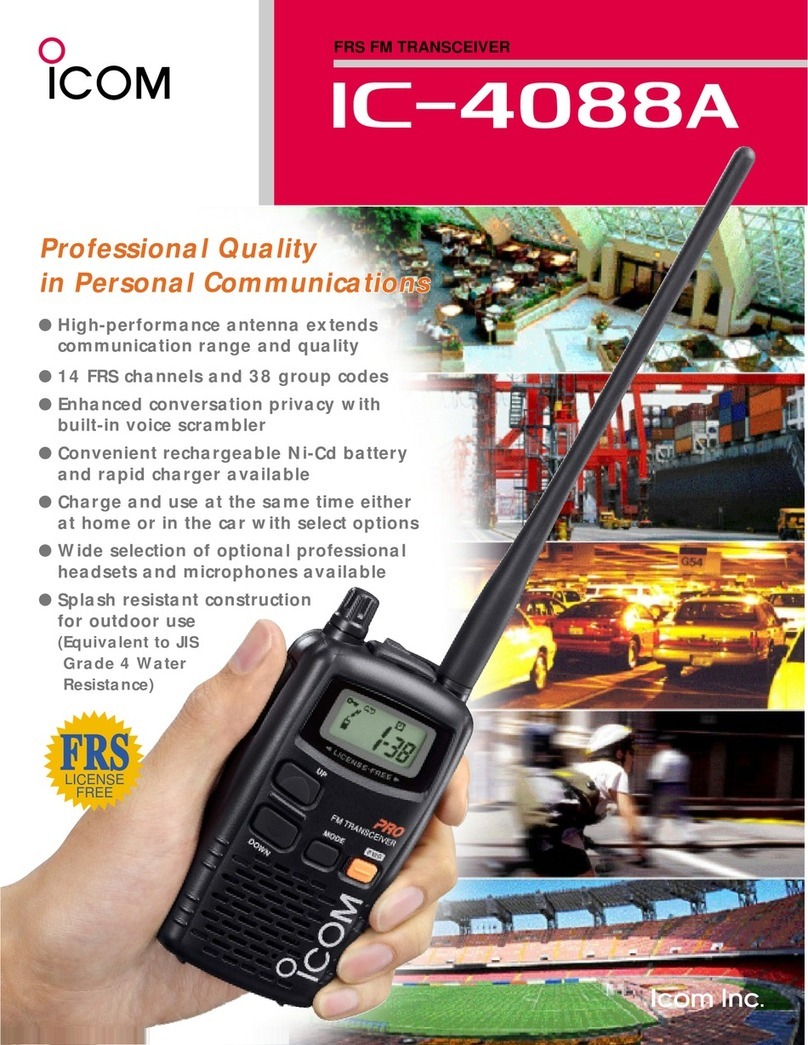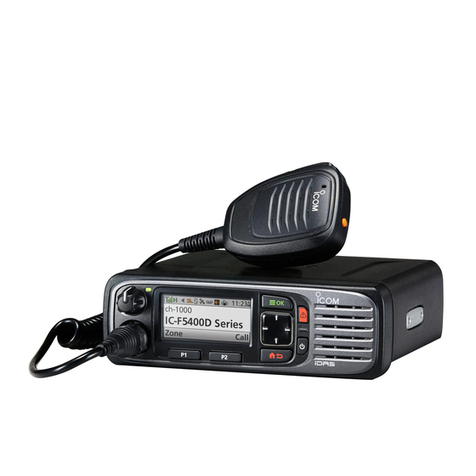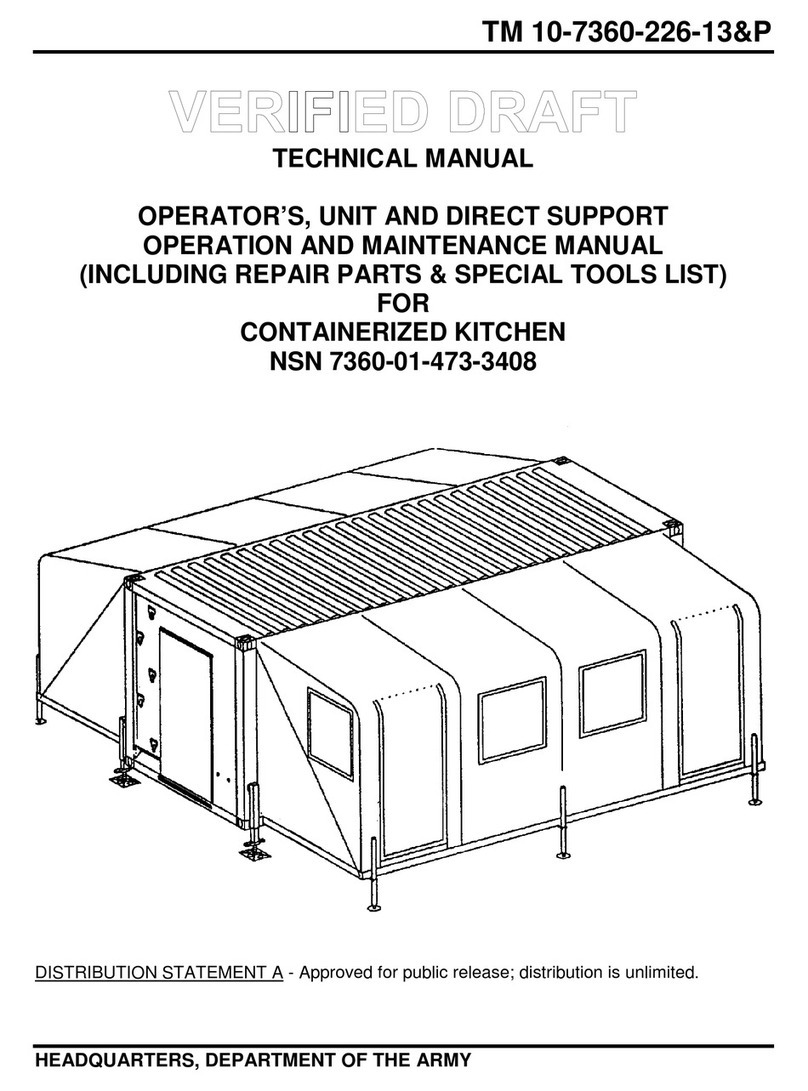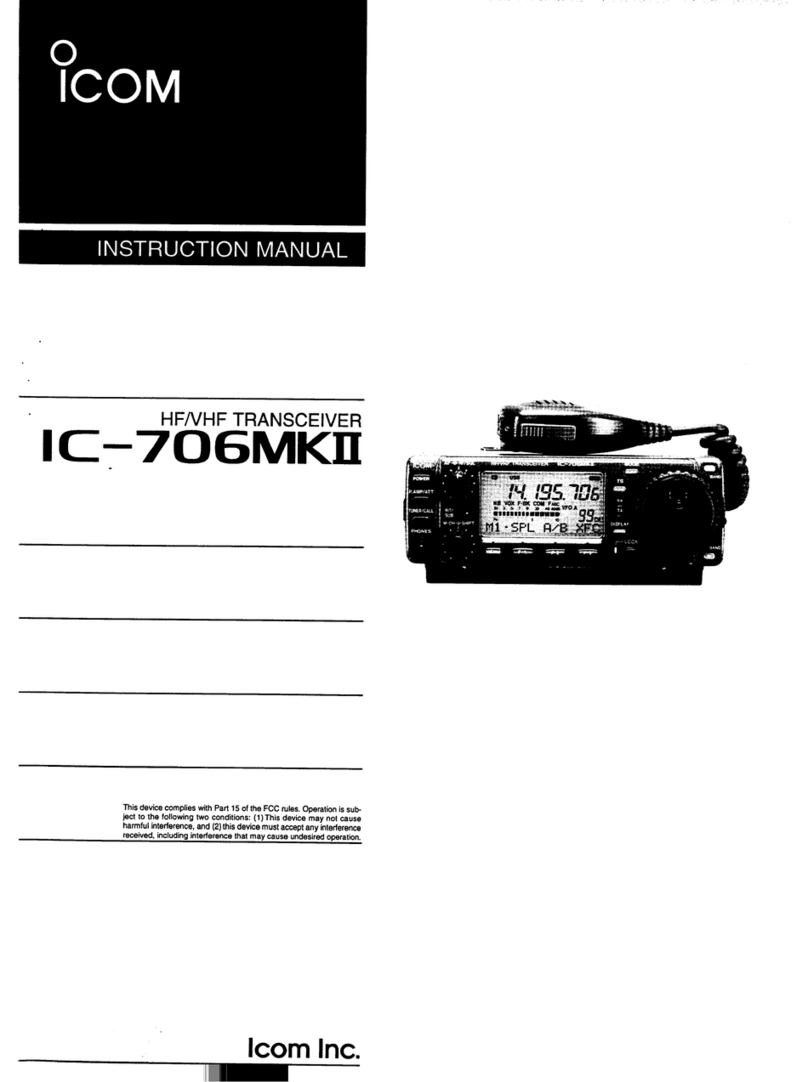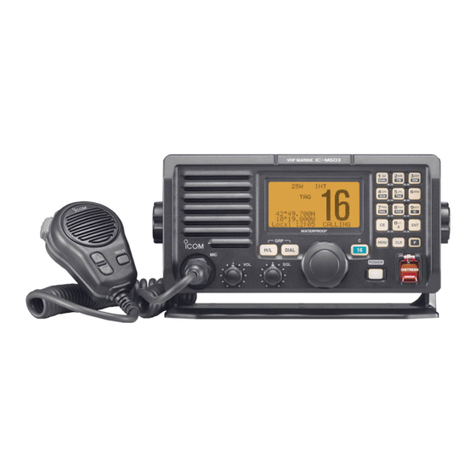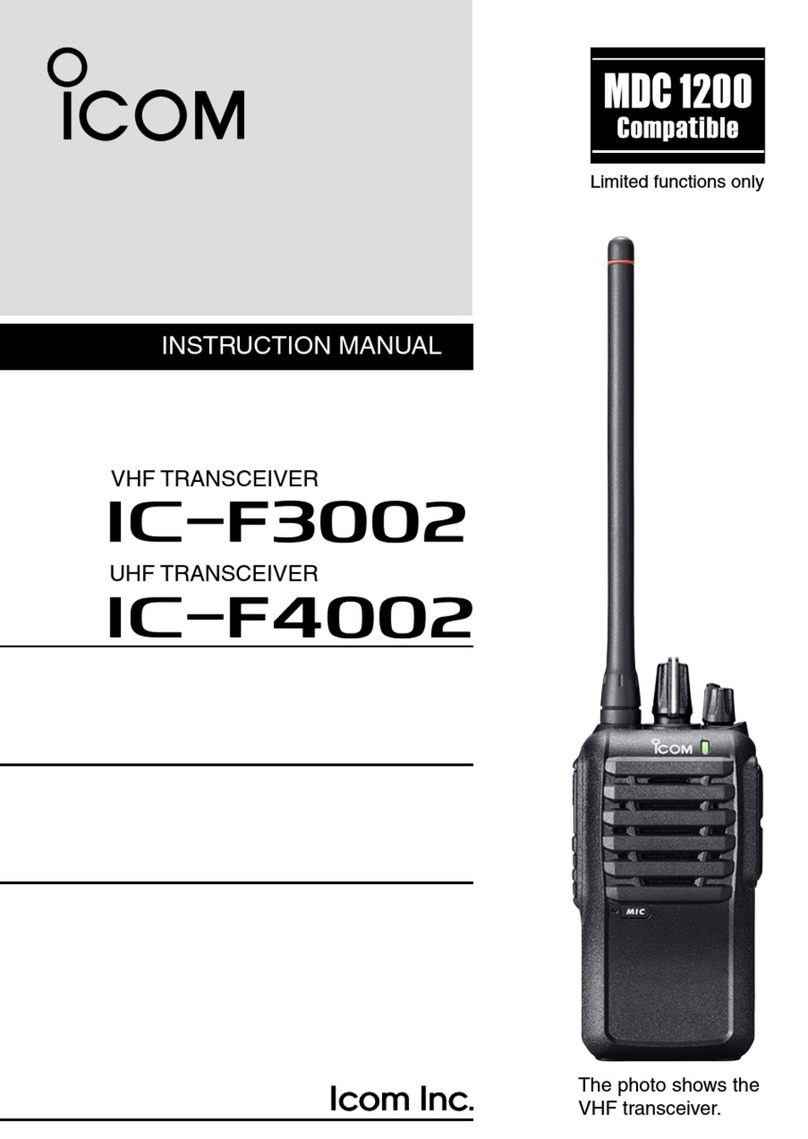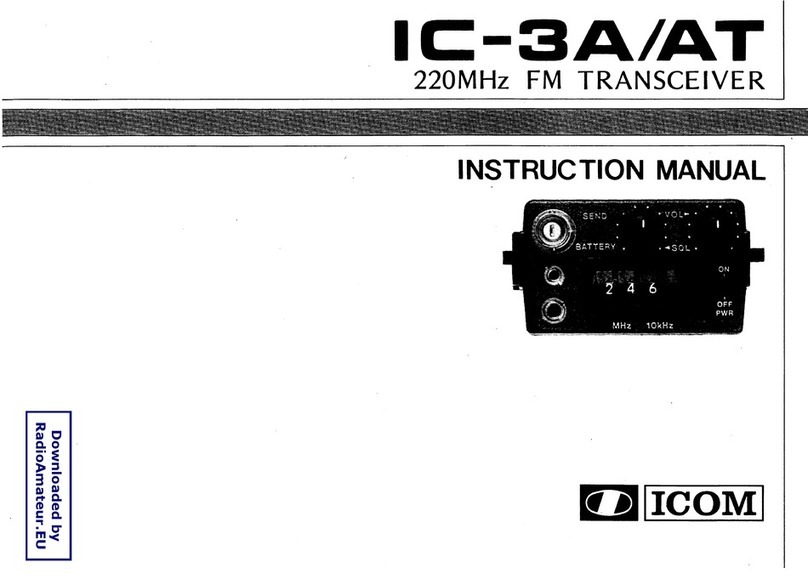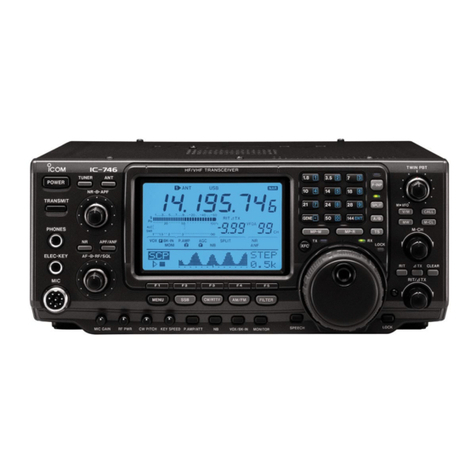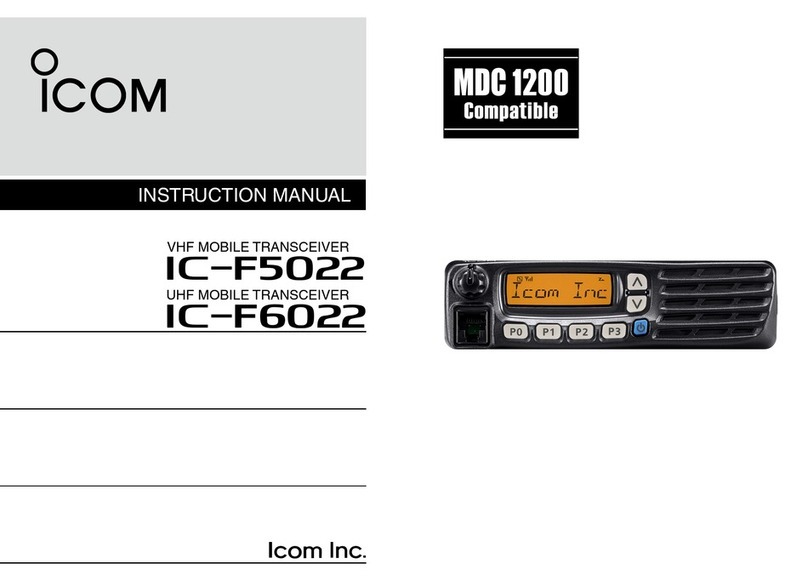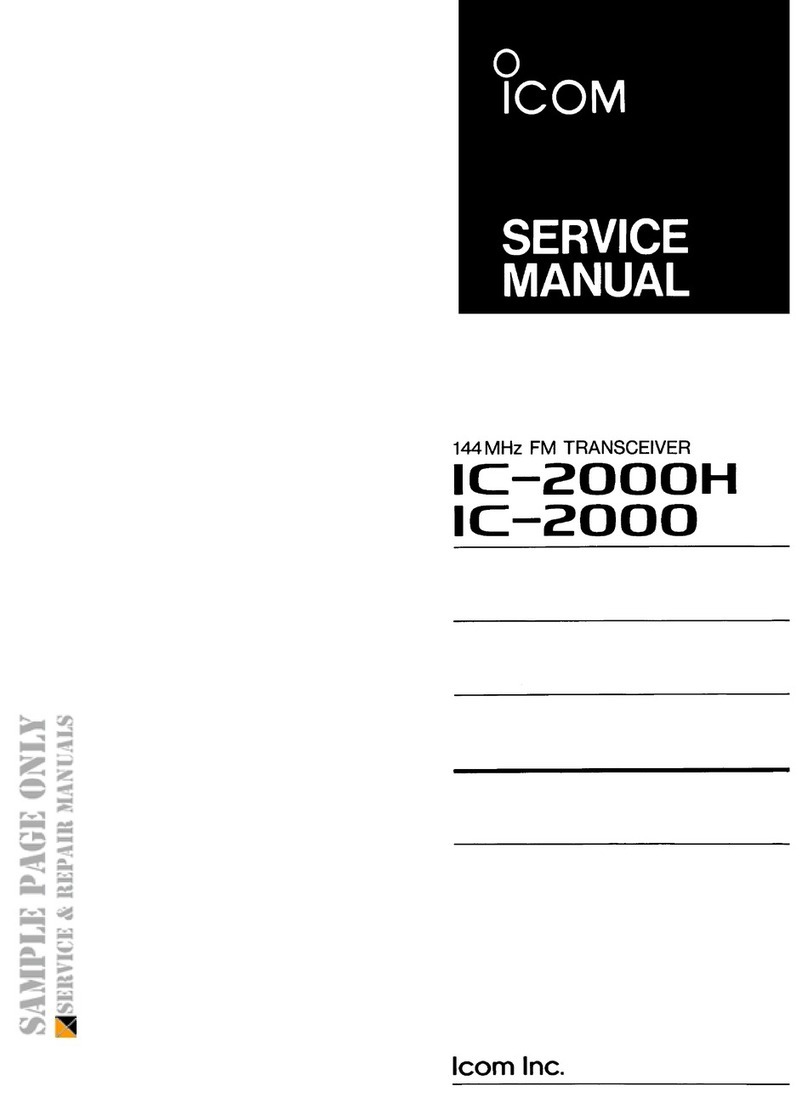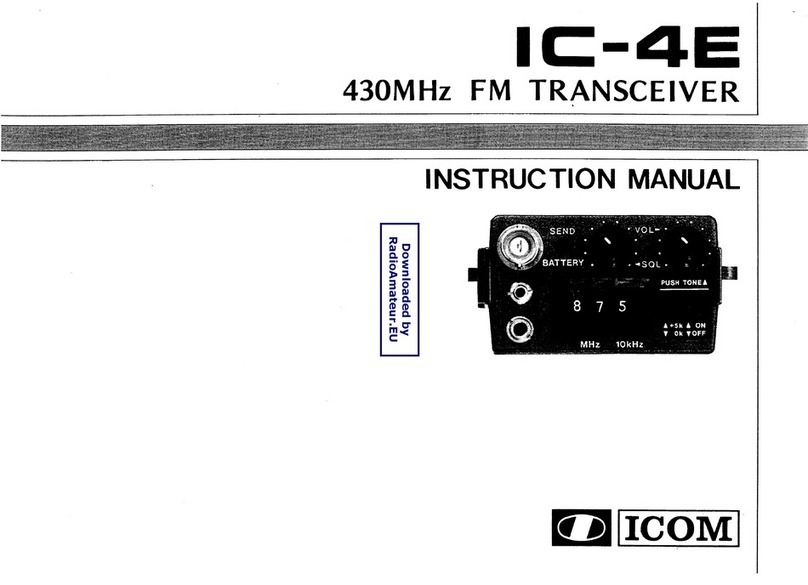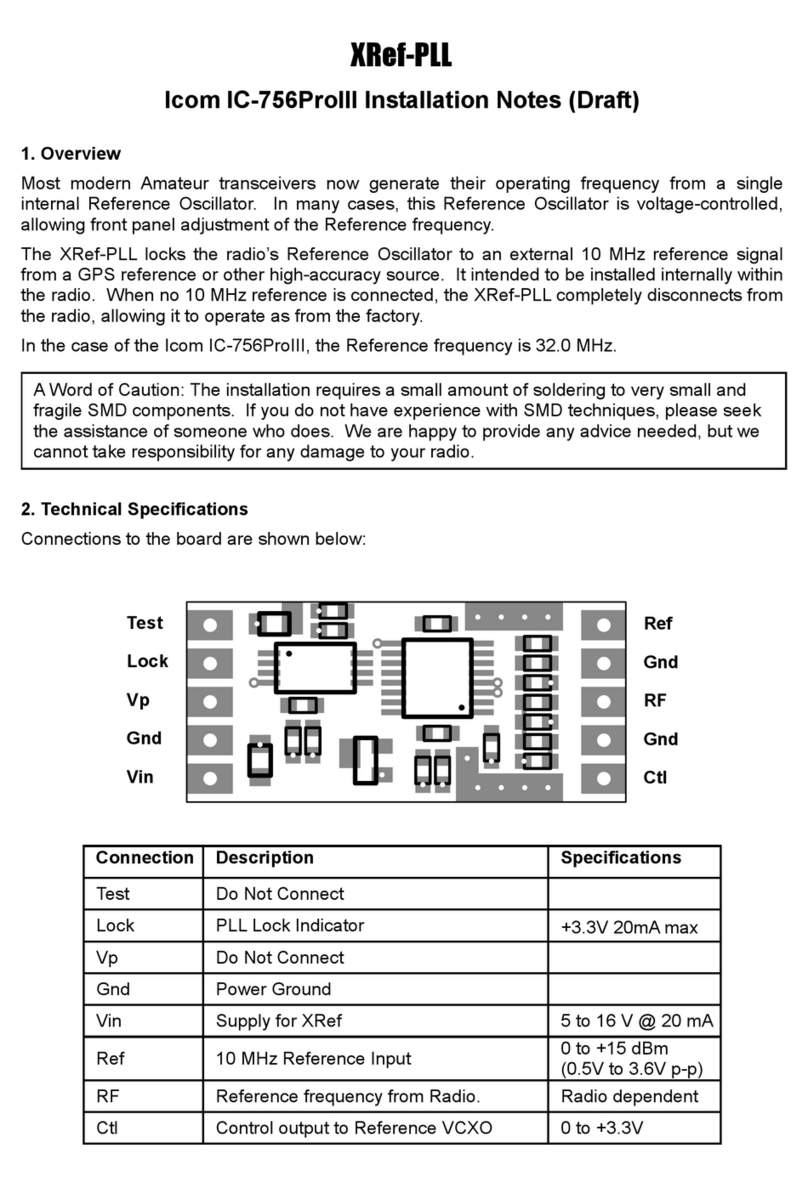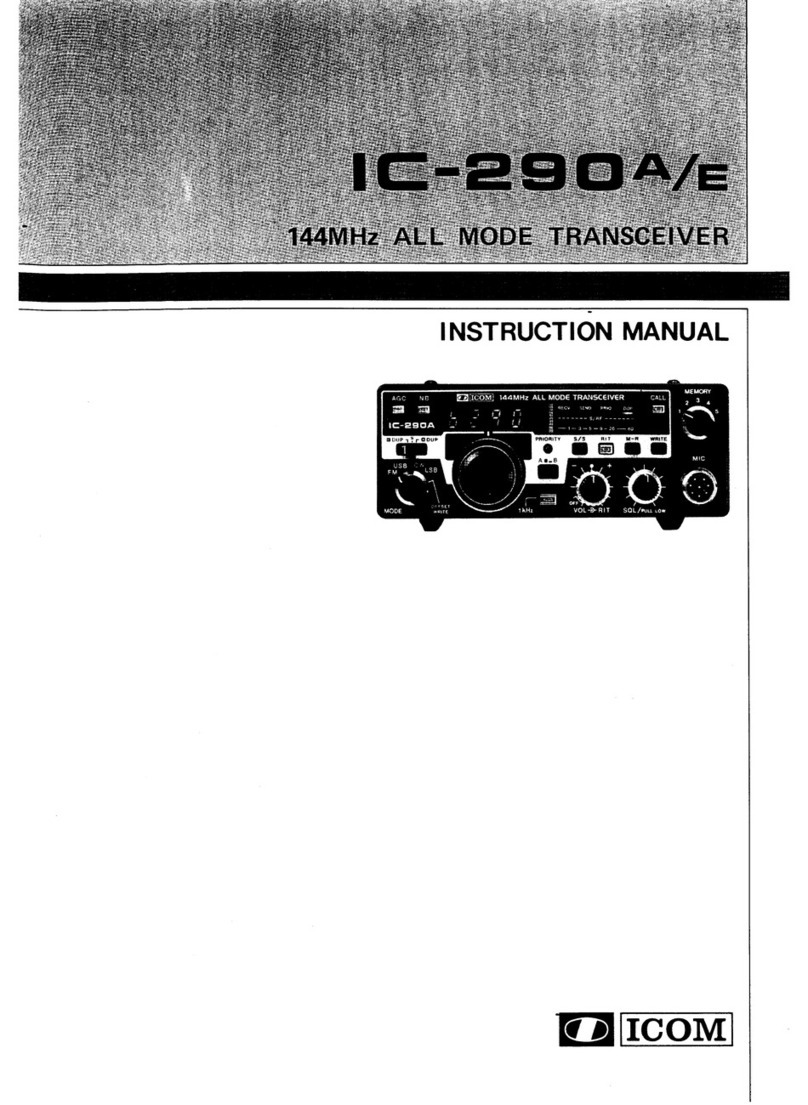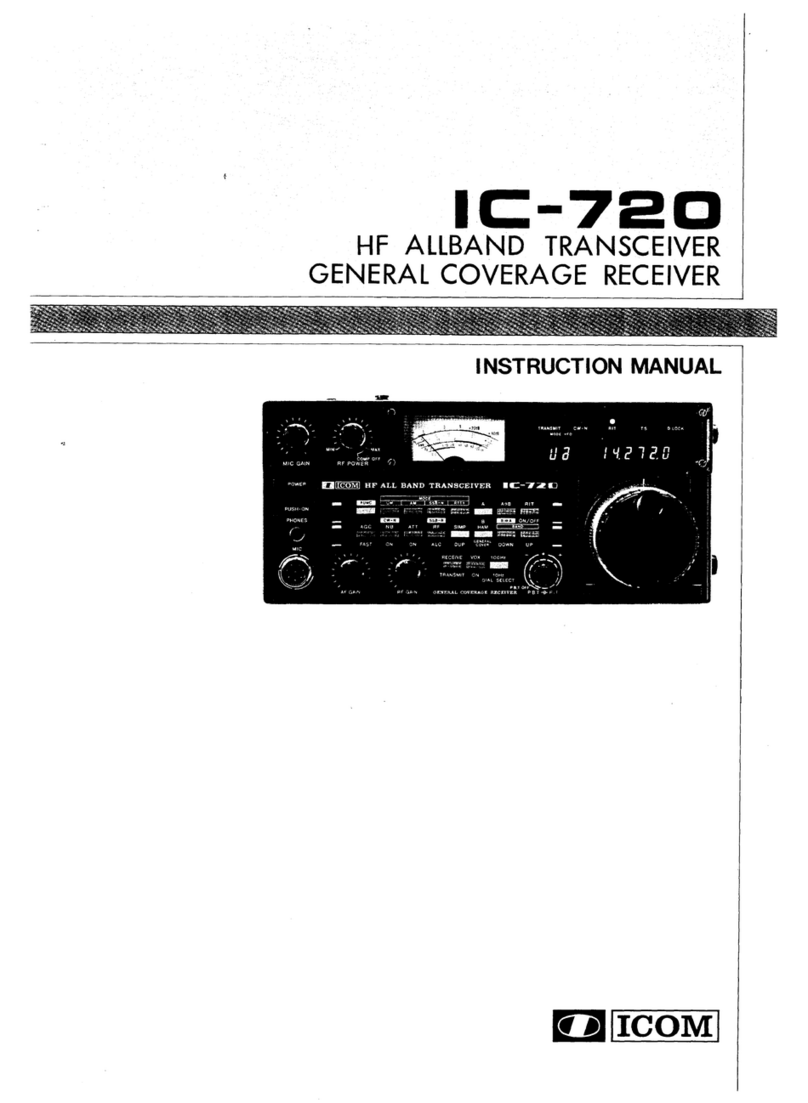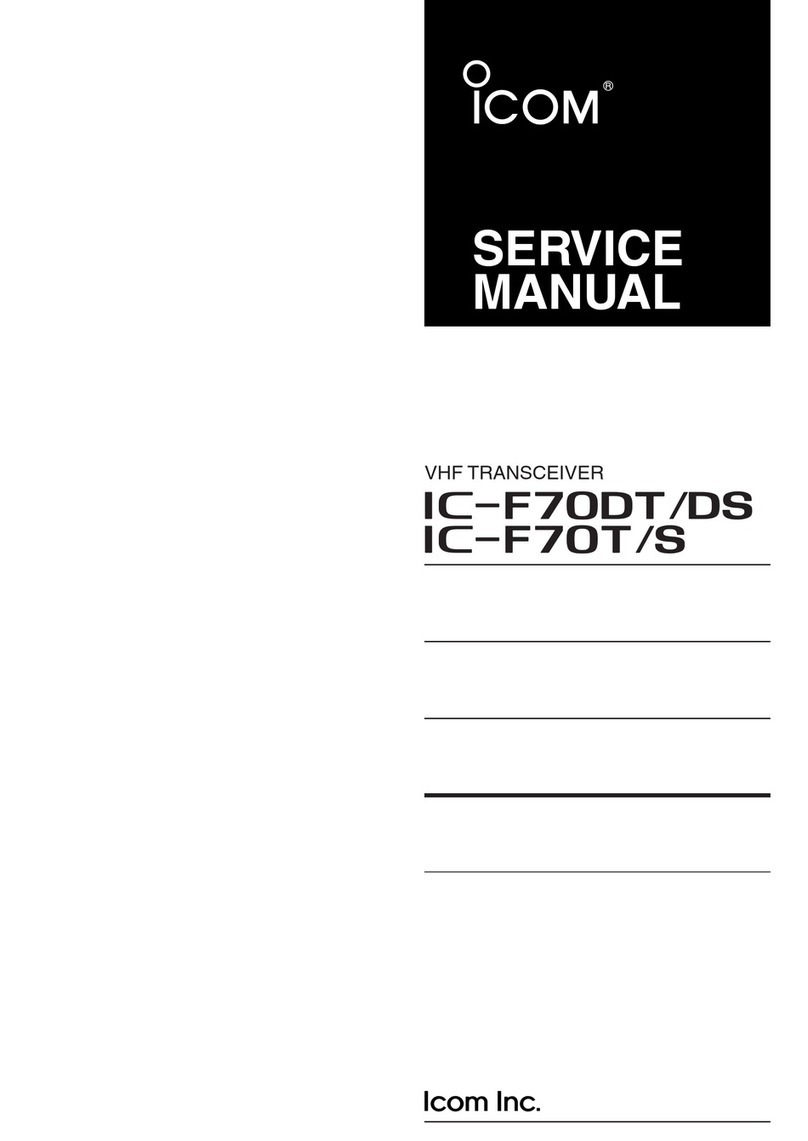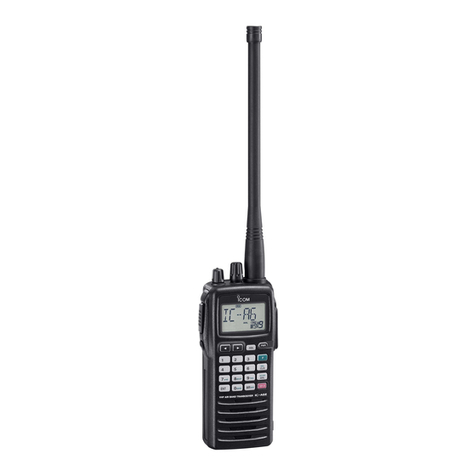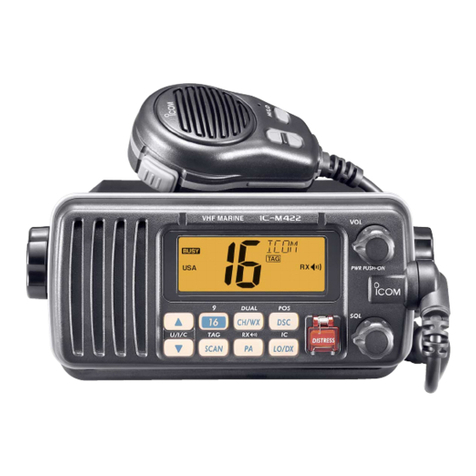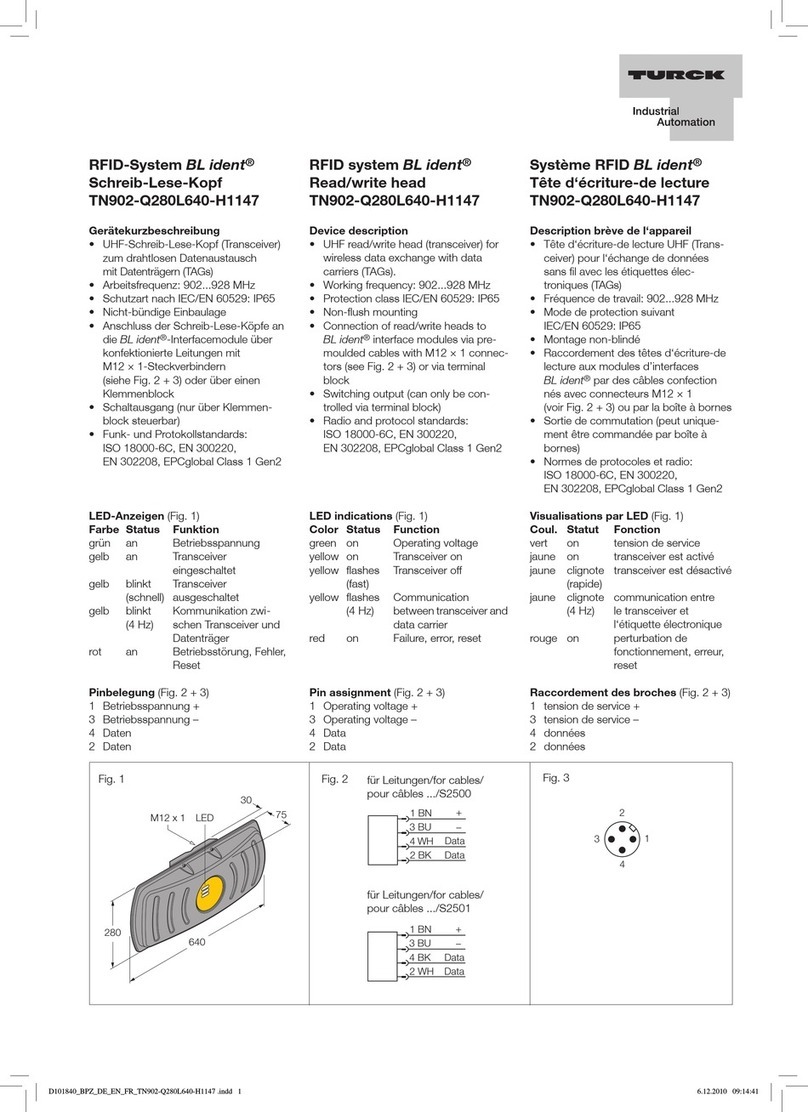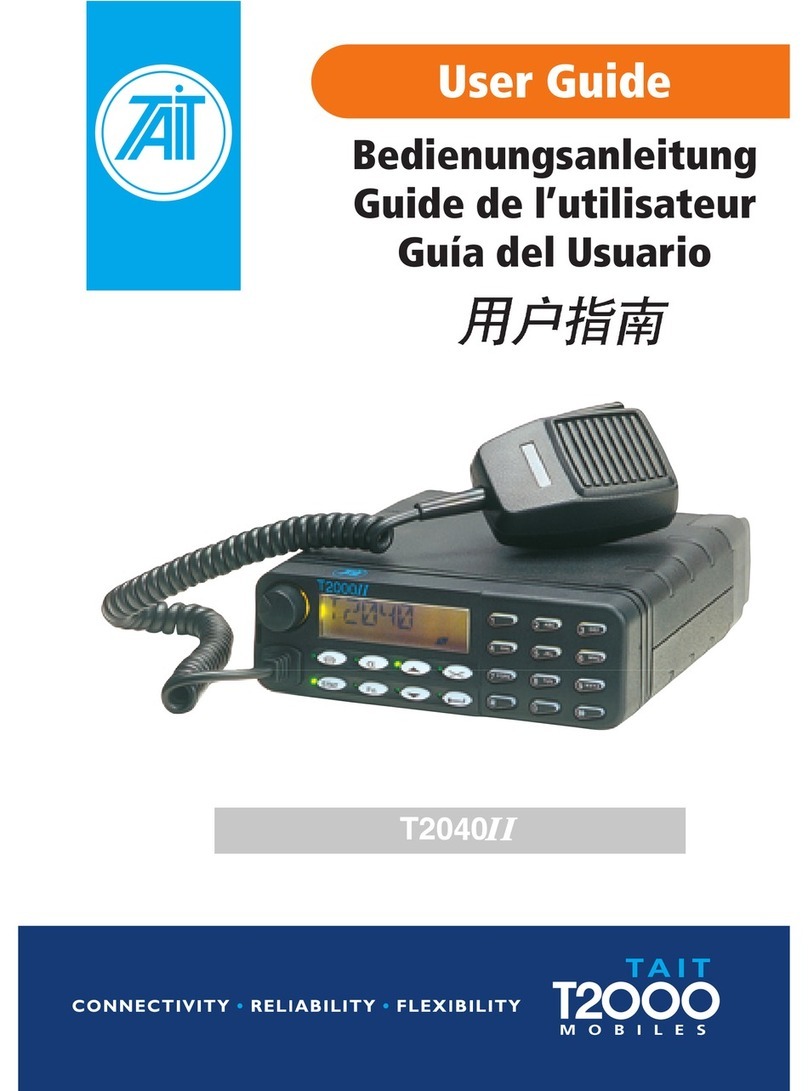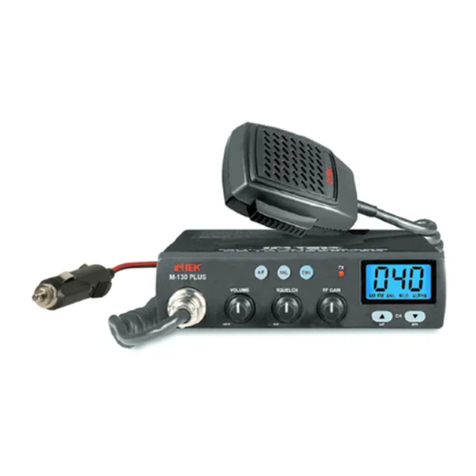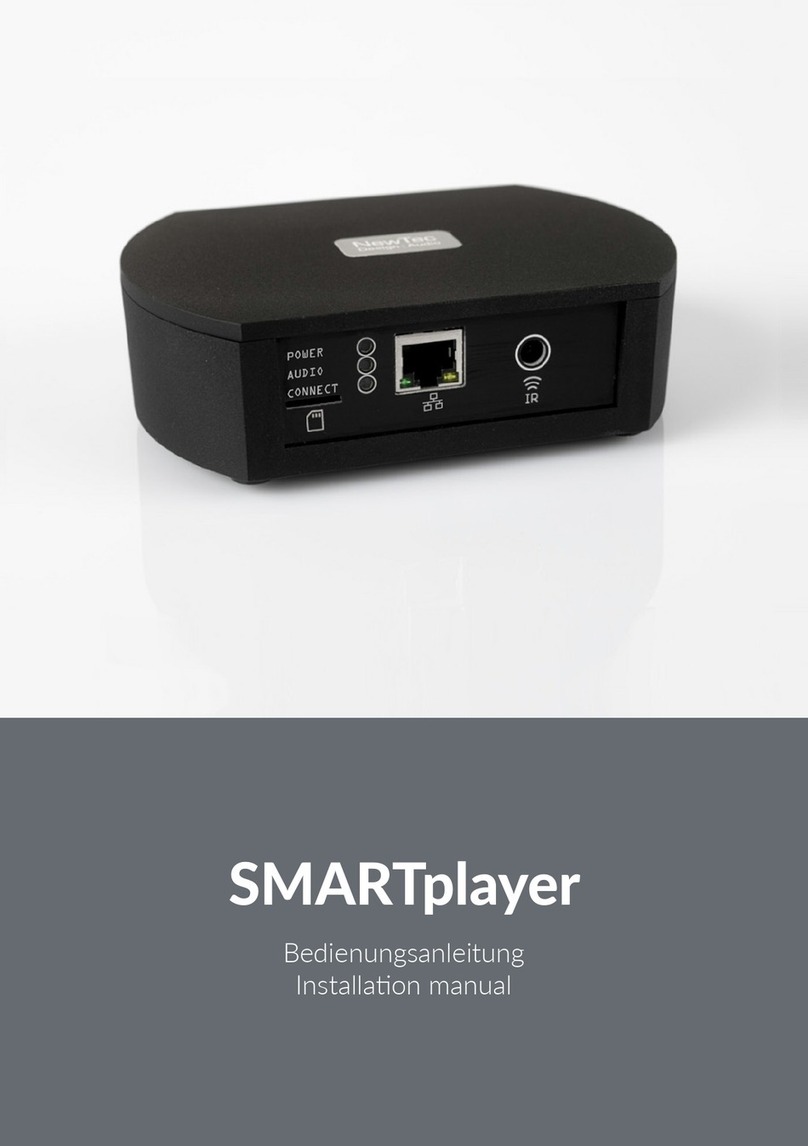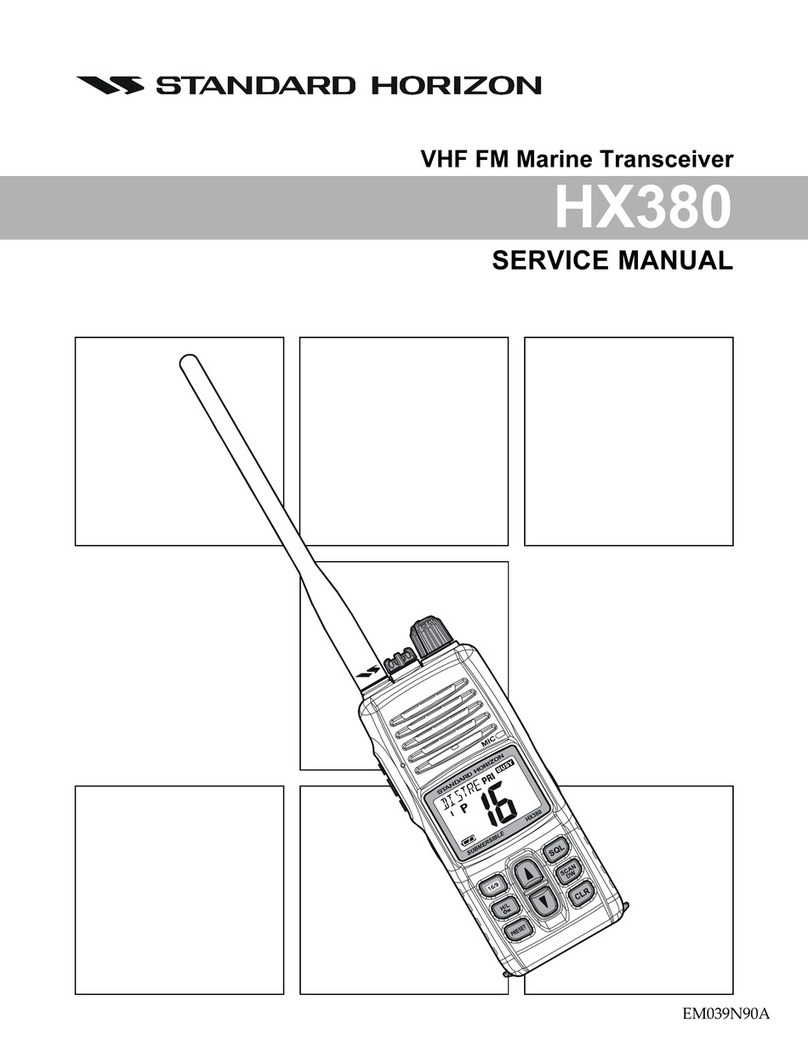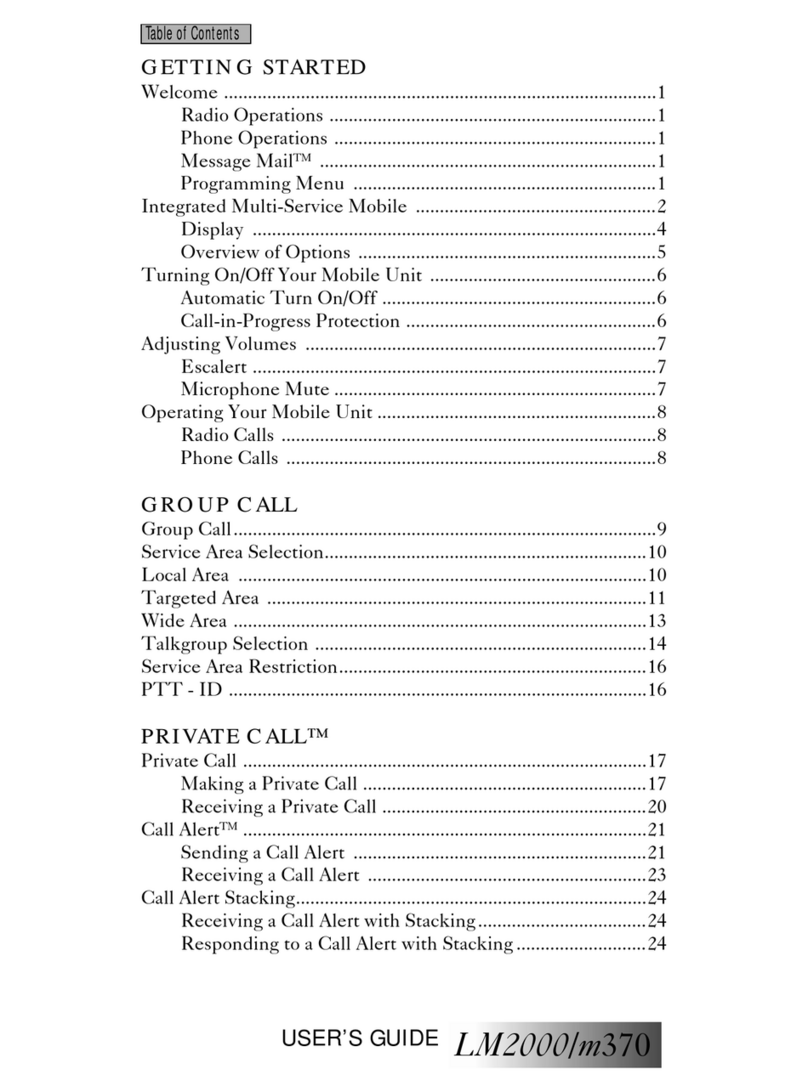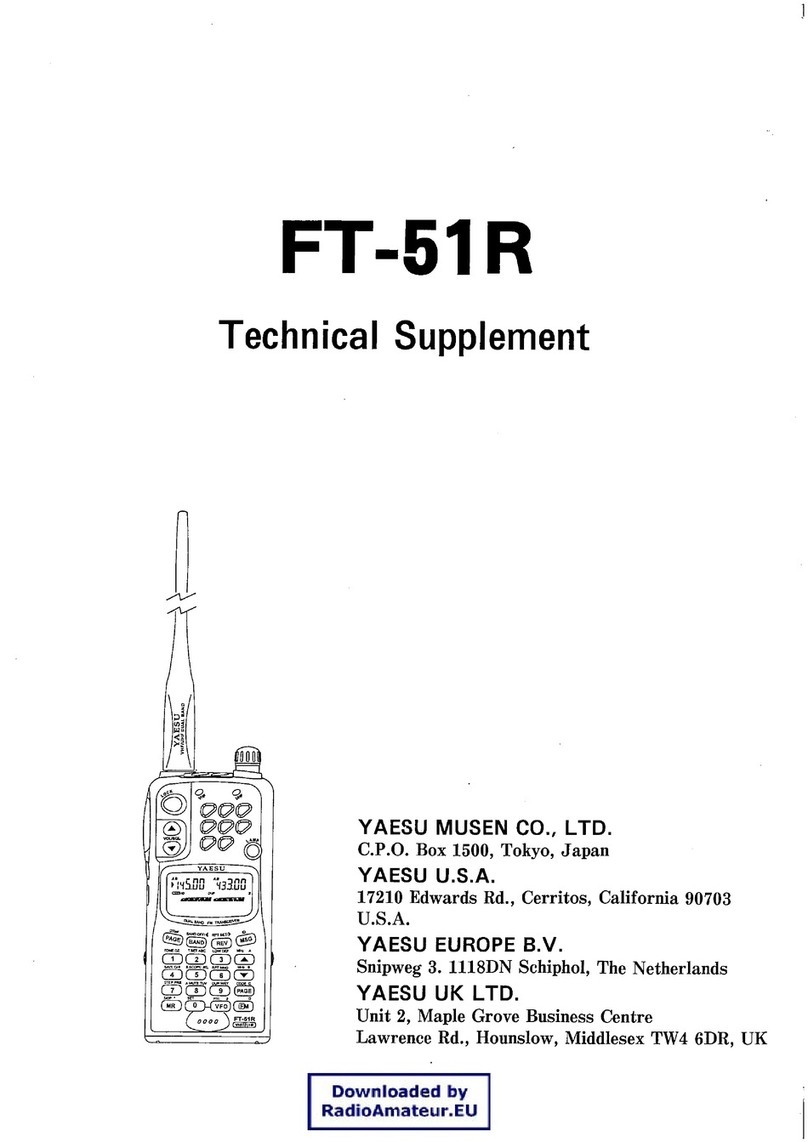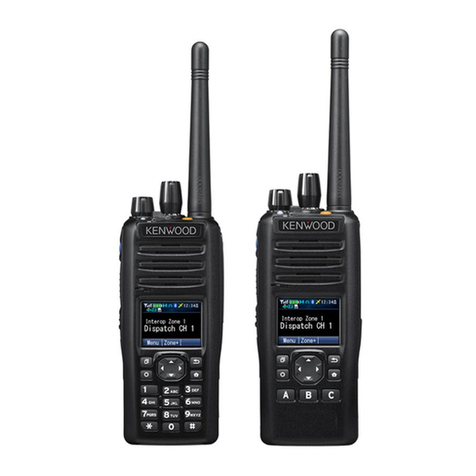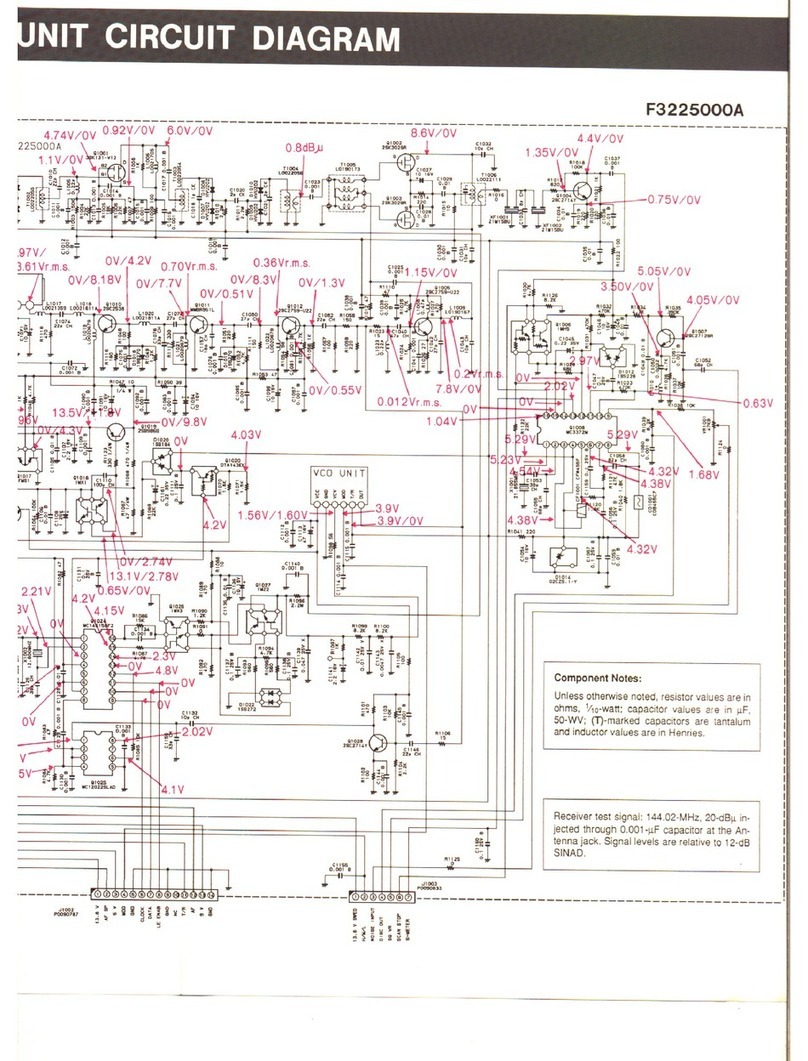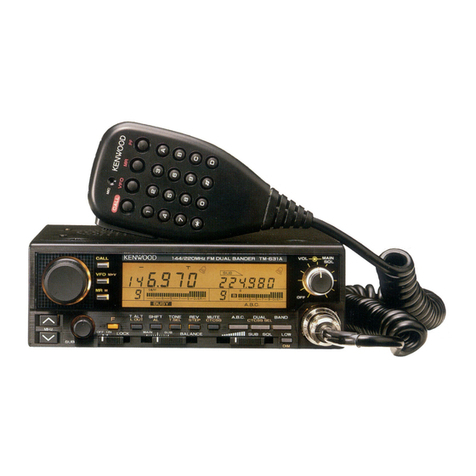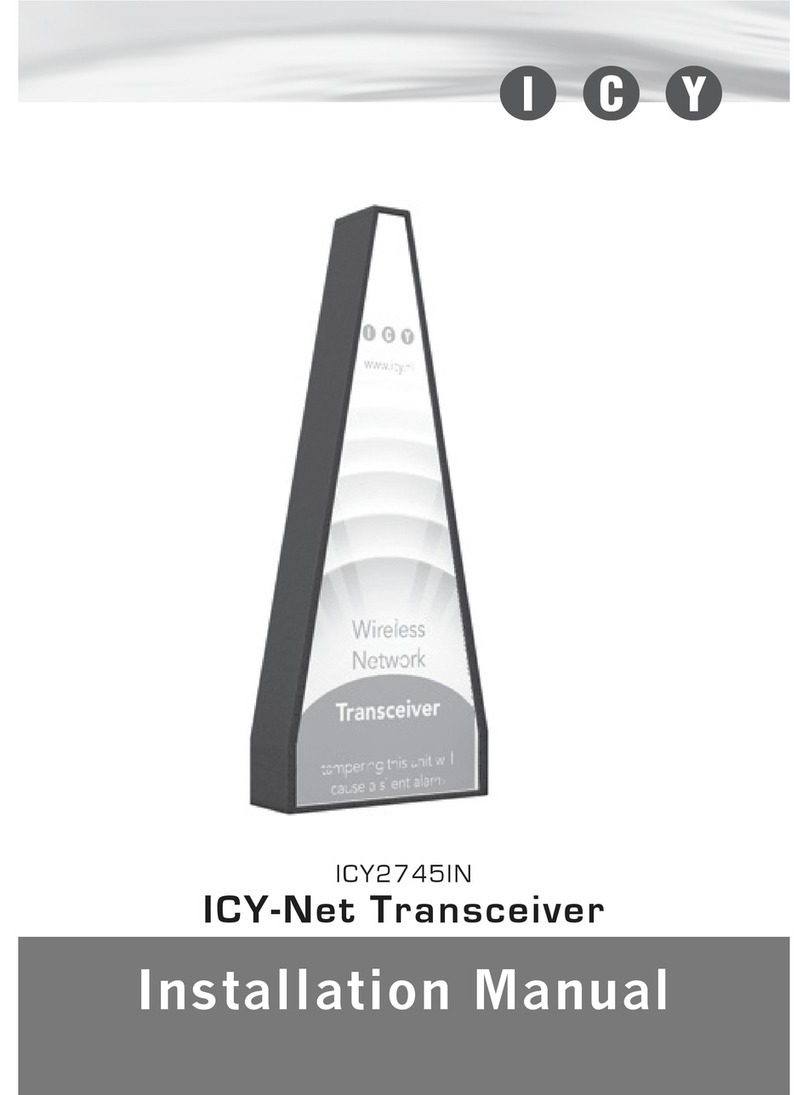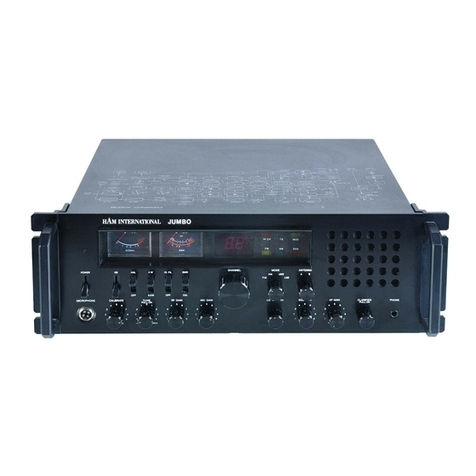Icom IC-F9020 SERIES User manual

OPERATING GUIDE
FOR IC-F9010/IC-F9020/
IC-F9510/IC-F9520 SERIES
ANALOG/APCO P25 MODE
OPERATIONS

i
Thank you for purchasing this Icom transceiver.
Your transceiver will operate on Analog and APCO P25 sys-
tems.
READ ALL INSTRUCTIONS OF THE SYSTEM
carefully and completely before using the transceiver.
SAVE THIS OPERATING GUIDE — This operating
guide contains important operating instructions for,
• IC-F9011B/S/T vhf p25 trunking handheld transceivers
• IC-F9021B/S/T, IC-F9023B/S/T uhf p25 trunking handheld
transceivers
• IC-F9511S/T/HT vhf p25 trunking mobile transceivers
• IC-F9521S/T, IC-F9523S/T uhf p25 trunking mobile trans-
ceivers
✔ INFORMATION:
In this operating guide, the following descriptions are used;
• “Non-display types” : Models ending in “B”
• “Simple types” : Models ending in “S”
• “10-key types” : Models ending in “T”
Icom, Icom Inc. and the Icom logo are registered trademarks of Icom Incor-
porated (Japan) in Japan, the United States, the United Kingdom, Germany,
France, Spain, Russia and/or other countries.
All other products or brands are registered trademarks or trademarks of their
respective holders.
IMPORTANT

ii
IMPORTANT.......................................................................... i
TABLE OF CONTENTS........................................................ ii
1 PREPARATION............................................................1–8
n Programmable key functions........................................1
2 ANALOG MODE OPERATION..................................9–10
n DTMF transmission ......................................................9
n Scrambler function .......................................................9
n Emergency transmission..............................................9
n Man Down Emergency Call
(Handheld types only) ................................................10
n Lone Worker Emergency Call.....................................10
3 APCO P25 MODE OPERATION .............................11–43
n General.......................................................................11
n Control Channel Hunt function
(P25 Trunking mode only) ..........................................12
n Roaming function (P25 Trunking mode only) .............14
n Site Lock function (P25 Trunking mode only) .............14
n Site Select function (P25 Trunking mode only)...........15
n Individual call..............................................................15
n Talkgroup call..............................................................17
n Pager function ............................................................19
n Radio Inhibit function..................................................21
n Radio Uninhibit function .............................................23
n Remote Monitor function ............................................25
n Radio Check function .................................................27
n Status Message .........................................................29
n Short Message...........................................................31
n Status Query function.................................................33
n Phone call ..................................................................35
n Announcement function .............................................37
n Emergency transmission............................................38
n Man Down Emergency Call
(Handheld types only) ................................................40
n Lone Worker Emergency Call.....................................40
n Encryption function.....................................................41
n OTAR function ............................................................41
4 TACTICAL GROUP FUNCTION..............................44–48
n Tactical Group function...............................................44
TABLE OF CONTENTS 1
2
3
4
5
6
7
8
9
10
11
12
13
14
15
16

nProgrammable key functions
The programmable key functions can be assigned to the fol-
lowing keys and switches;
Handheld transceivers:
[EMR], [Side1], [Side2], [Side3], [I]*1, [II]*1, [III]*1, [Ω]*1, [≈]*1,
[∫]*1, [√]*1, [APP]*1, [HOME]*1, ABC switch and Toggle
switch.
Mobile transceivers:
[UP]*2, [DOWN]*2, [P0], [P1], [P2], [P3] and [P4].
*1Available on Simple and 10-key types only
*2Available on 10-key types only
Consult your Icom dealer or system operator for details con-
cerning your transceiver’s PC programming.
For Handheld transceivers:
❍ABC and Toggle switches
The programmable key functions for the ABC and Toggle
switches are limited. (See p. 8 for details.)
❍Key indicator (Simple and 10-key types only)
If the key indicator shows the programmed function key
name, push the front panel key ([I], [II] or [III]) under the key
indicator to activate the programmed function.
(In the explanations that follow, the function key name for that
key indicator is displayed in double quotation marks; e.g.
“EMR.”)
❍Non-display types
The programmable key functions are limited, and some key
functions operate differently between the Simple and 10-key
types.
1
1PREPARATION

2
1
PREPARATION
1
2
3
4
5
6
7
8
9
10
11
12
13
14
15
16
DProgrammable key functions availability
HH: Handheld MB: Mobile IM: Instruction Manual N/A: Not Applicable
*1Display and non-display units operate differently.
*2Not available on Non-display types.
Programmable
key functions
Analog APCO P25 REF.
HH MB HH MB
CH Up/Down ✔ ✔ ✔ ✔ IM
Zone Up/Down N/A ✔N/A ✔IM
Zone ✔ ✔ ✔ ✔ IM
Scan A Start/Stop,
Scan B Start/Stop ✔ ✔ ✔ ✔ IM
Scan Add/Del(Tag) ✔ ✔ ✔ ✔ IM
PrioA, PrioB ✔ ✔ ✔ ✔ IM
PrioA(Rewrite),
PrioB(Rewrite) ✔ ✔ ✔ ✔ IM
MR-CH 1, 2, 3, 4 ✔ ✔ ✔ ✔ IM
Moni ✔ ✔ ✔ ✔ IM
Public Address N/A ✔N/A ✔IM
RX Speaker N/A ✔N/A ✔IM
Light ✔ ✔ ✔ ✔ IM
Lock ✔ ✔ ✔ ✔ IM
Talk Around ✔ ✔ ✔ ✔ IM
Programmable
key functions
Analog APCO P25 REF.
HH MB HH MB
High/Low ✔ ✔ ✔ ✔ IM
Surveillance ✔ ✔ ✔ ✔ IM
Hook Scan N/A ✔N/A ✔IM
OPT1 Out, OPT2 Out,
OPT3 Out ✔*1✔ ✔*1✔IM
OPT1 Momentary,
OPT2 Momentary,
OPT3 Momentary
✔ ✔ ✔ ✔ IM
User Set Mode ✔*2✔ ✔*2✔IM
Clock ✔ ✔ ✔ ✔ IM
Menu <, Menu > ✔N/A ✔N/A IM
Re-dial ✔ ✔ N/A N/A p. 3
DTMF Autodial ✔*1✔N/A N/A p. 3
Scrambler ✔*1✔N/A N/A pgs. 3, 8
Compander ✔*1✔N/A N/A pgs. 4, 8
Lone Worker ✔ ✔ ✔ ✔ p. 4

3
1PREPARATION
Programmable
key functions
Analog APCO P25 REF.
HH MB HH MB
Emergency ✔ ✔ ✔ ✔ p. 4
Ext.CH Sel Mode N/A ✔N/A ✔p. 4
Home ✔ ✔ ✔ ✔ p. 4
Scrambler/Encryption ✔*1✔ ✔*1✔pgs. 5, 8
Zeroize N/A N/A ✔ ✔ p. 6
Site Lock N/A N/A ✔ ✔ pgs. 6, 8
Encryption N/A N/A ✔*1✔pgs. 6, 8
Digital Button N/A N/A ✔*2✔p. 6
Dgital Page N/A N/A ✔*2✔p. 6
Digital Status N/A N/A ✔*2✔p. 7
Digital Message N/A N/A ✔*2✔p. 7
Phone N/A N/A ✔*2✔p. 7
Individual N/A N/A ✔*2✔p. 7
Talkgroup N/A N/A ✔*2✔p. 7
Site Select N/A N/A ✔*2✔p. 8
Rekey N/A N/A ✔*2✔p. 8
Keyset N/A N/A ✔*2✔p. 8
DProgrammable functions availability (Continued) DAnalog mode operation
(Common operation)
RE-DIAL KEY “DTMR”
Push to transmit the last-transmitted DTMF code.
(Display and non-display units operate differently)
DTMF AUTODIAL KEY “DTMA”
❍For Simple and 10-key types
➥Push to enter the DTMF channel selection mode.
Then select the desired channel using [CH Up]/[CH Down]
or [CH Up/Down].
➥After selecting the channel, push this key to transmit the
DTMF code.
❍For Non-display types
➥Push to transmit the DTMF code.
SCRAMBLER KEY “SCR”
❍For Simple and 10-key types
Push to turn the Voice Scrambler function ON or OFF.
❍For Non-display types
➥Push and hold for 1 sec. to turn the Voice Scrambler func-
tion ON.
➥If the function is ON, push the key to turn it OFF.
H.H.: Handheld M.B.: Mobile
IM: Instruction Manual N/A: Not Applicable
*1Display and non-display units operate differently.
*2Not available on Non-display types.

4
1
PREPARATION
1
2
3
4
5
6
7
8
9
10
11
12
13
14
15
16
COMPANDER KEY “COMP”
❍For Simple and 10-key types
Push to turn the Compander function ON or OFF.
This function reduces noise components from the transmit-
ted audio to provide clear communication.
❍For Non-display types
➥Push and hold for 1 sec. to turn the Compander function
ON.
➥If the function is ON, push the key to turn it OFF.
DAnalog and APCO P25 modes operation
(Common operation)
LONE WORKER KEY “LONE”
Push to turn the Lone Worker function ON or OFF.
• If the Lone Worker function is activated, the Emergency function is
automatically turned ON after the specified time period* has passed
with no operation performed.
* Depending on the pre-setting. Ask your dealer for details.
EMERGENCY KEY “EMR”
Push and hold for the specified time period*, to enter the
emergency mode. After the specified time period* has
passed, an Emergency call or alarm is transmitted once, or
repeatedly. (pgs. 7, 35)
• To exit the emergency mode, push and hold for the specified time pe-
riod* again before transmitting.
* Depending on the pre-setting. Ask your dealer for details.
Ext. CH Sel Mode KEY (Available on only the mobile types)
Push to turn the Memory Channel Select function from exter-
nal input operation ON or OFF.
When this function is turned ON, and a signal is input from an
external unit that is connected to the D-sub 25-pin connector,
the operating channel changes to the desired memory chan-
nel. In this case, a memory channel selection with the key or
dial operation, and the microphone hanger action functions,
Move to Priority A Channel and On Hook Scan, are disabled.
When this function is turned OFF, the memory channel selec-
tion from external input operation is disabled.
• This function is usable when an external unit is connected to the
transceiver.
• Ask your dealer for details of the external input operation.

5
1PREPARATION
DAnalog and APCO P25 modes operation (Continued)
HOME KEY “HOME”
➥Push to return to the normal operating mode from each
selected mode, such as Individual ID, Talkgroup ID, DTMF
code channel, and so on.
➥When the Full Off Air Call SetUp (FOACSU) function is
turned ON on the Trunking mode, push to ignore the re-
ceiving call. (p. 16)
(Display and non-display units operate differently)
SCRAMBLER/ENCRYPTION KEY “S/D”
(The optional UT-125 aes/des encryption unit is required for encryption.)
❍For Simple and 10-key types
➥While in the analog mode, push to turn the Voice Scrambler
function ON or OFF.
➥While in the APCO P25 mode, push to turn the Encryption
function ON or OFF.
➥While in the mixed (digital and analog) mode, push to turn
the Voice Scrambler and Encryption functions ON or OFF,
separately or simultaneously, as shown below.
Voice Scrambler function ON (“SCRM” appears* / “ ” appears)
Voice Scrambler and Encryption functions ON
(“SCRM/ENC” appears* / “ ” appears)
Voice Scrambler and Encryption functions OFF
(“OFF” appears* / “ ” disappears)
Encryption function ON (“ENC” appears* / “ ” appears)
PUSH
PUSH
PUSH
PUSH * Appears for about 1 sec.
❍For Non-display types
➥While in the analog mode, push and hold for 1 sec. to turn
the Voice Scrambler function ON. If the function is ON,
push the key to turn it OFF.
➥While in the APCO P25 mode, push and hold for 1 sec.
to turn the Encryption function ON. If the function is ON,
push the key to turn it OFF.
➥While in the mixed (digital and analog) mode, push and
hold for 1 sec. to turn both the Voice Scrambler and
Encryption functions ON. If the functions are ON, push the
key to turn them OFF.

DFor APCO P25 mode operation
(Common operation)
ZEROIZE KEY “ZERO”
Push and hold this key for 1 sec. to zeroize the encryption
key data which is programmed by the key loader.
After this operation is performed, the transceiver cannot
decrypt the encrypted code.
SITE LOCK KEY “SLCK” (Trunking mode only) (p. 14)
Push to lock the transceiver in the current registered site.
When the Site Lock function is activated, roaming and the
background scan are inhibited.
Push again to turn the Site Lock function OFF.
(Display and non-display units operate differently)
ENCRYPTION KEY “DENC” (p. 41)
(The optional UT-125 aes/des encryption unit is required.)
❍For Simple and 10-key types
Push to turn the Encryption function ON or OFF.
❍For Non-display types
➥Push and hold for 1 sec. to turn the Encryption function
ON.
➥If the function is ON, push the key to turn it OFF.
(Not available for Non-display types)
DIGITAL BUTTON KEY “DSEL”
➥Push to enter the digital call type selection mode. Then
push [CH Up]/[CH Down] or rotate [CH Up/Down] to
select the desired call type from “PAGE,” “RDO INHIBIT,”
“RDO UINHIBIT,” “RDO MONITOR,” “RDO CHECK,”
“STATUS,” “SHORT MSG,” “STATUS QUERY,” “PHONE”
and “ANNOUNCEMENT.” (p. 11)
After making the digital call type selection, push this key
again to enter the ID selection mode.
• If “STATUS” or “SHORT MSG” is selected, the transceiver dis-
plays the Status Message or Short Message selection mode
before entering the Individual ID selection mode.
• If “PHONE” is selected, the transceiver displays the phone
number selection mode.
• If no operation is performed for about 30 sec., the transceiver
returns to normal operation.
➥Push and hold for 1 sec. to cancel and return to normal
operation.
DIGITAL PAGE KEY “PAGE” (p. 19)
➥Push to enter the Individual ID selection mode for a Page
call. Then push [CH Up]/[CH Down] or rotate [CH Up/
Down] to select the desired Individual ID.
• Push [PTT] to transmit a Page call.
• If no operation is performed for about 30 sec., the transceiver
returns to normal operation.
➥Push and hold for 1 sec. to cancel and return to normal
operation.
6
1
PREPARATION
1
2
3
4
5
6
7
8
9
10
11
12
13
14
15
16

DIGITAL STATUS KEY “STAT” (p. 29)
➥Push to enter the Status Message selection mode.
After selecting the desired Status Message, push again to
enter the destination Individual ID selection mode to send
a Status Message.
• If no operation is performed for about 30 sec., the transceiver
returns to normal operation.
• While in the Trunking mode, the Individual ID selection mode
does not appear.
➥Push and hold for 1 sec. to cancel and return to normal
operation.
DIGITAL MESSAGE KEY “MSG” (p. 31)
➥Push to enter the Short Message selection mode.
After selecting the Short Message, push again to enter the
destination Individual ID selection mode to send a Short
Message.
• If no operation is performed for about 30 sec., the transceiver
returns to normal operation.
• While in the Trunking mode, the Individual ID selection mode
does not appear.
➥Push and hold for 1 sec. to cancel and return to normal
operation.
PHONE KEY “PHON” (p. 35)
➥Push to enter the phone number selection mode for a
Phone call. Then push [CH Up]/[CH Down] or rotate [CH
Up/Down] to select the desired phone number.
• Push [PTT] to transmit the Phone call.
• If no operation is performed for about 30 sec., the transceiver
returns to normal operation.
➥Push and hold for 1 sec. to cancel and return to normal
operation.
INDIVIDUAL KEY “INDV” (p. 15)
Push to directly enter the Individual ID selection mode. Then
select the desired Individual ID code using [CH Up]/[CH
Down] or [CH Up/Down].
• The Individual ID can be edited with the 10-keypad*. (Depending
on the pre-setting.)
*10-key types only.
• While in the Individual ID selection mode, push to cancel and
return to normal operation.
TALKGROUP KEY “TGID” (p. 17)
Push to directly enter the Talkgroup ID selection mode. Then
select the desired Talkgroup ID code using [CH Up]/[CH
Down] or [CH Up/Down].
• During the Talkgroup ID selection, push to cancel and return to
normal operation.
7
1PREPARATION

SITE SELECT KEY “SSEL” (Trunking mode only) (p. 15)
Push to select “SITE 1,” then push again to display the site
information (RFSS ID and SITE ID), and you can edit the
RFSS and SITE IDs. Push and hold [Site Select] for 1 sec.
to set and return to normal operation.
REKEY “REKY” (OTAR mode only) (p. 42)
Push and hold for 1 sec. to transmit a Key Management
Message (KMM-Hello command) to a Key Management
Facility (KMF) to request rekeying.
KEYSET “KSET” (OTAR mode only) (p. 43)
➥Push to enter the keyset selection mode, then select the
desired keyset using [CH Up]/[CH Down] or [CH Up/
Down].
➥During the keyset selection mode, push and hold this key
for 1 sec. to set the selected keyset, and push again to exit
the keyset selection mode.
DFor ABC and Toggle switches only
SCRAMBLER SWITCH (Analog mode only)
Turns the Voice Scrambler function ON or OFF.
COMPANDER SWITCH (Analog mode only)
Turns the Compander function ON or OFF.
The Compander function reduces noise components from
the transmitted audio to provide clear communication.
SCRAMBLER/ENCRYPTION SWITCH
(Analog and APCO P25 modes)
(The optional UT-125 aes/des encryption unit is required for
encryption.)
➥While in the analog mode, turns the Voice Scrambler
function ON or OFF.
➥While in the P25 Conventional mode, turns the Encryption
function ON or OFF.
➥While in the mixed (digital and analog) mode, simultane-
ously turns the Voice Scrambler and Encryption functions
ON or OFF.
ENCRYPTION SWITCH (APCO P25 mode only)
(The optional UT-125 aes/des encryption unit is required.)
Turns the Encryption function ON or OFF.
SITE LOCK SWITCH (APCO P25 Trunking mode only)
Locks the transceiver in the currently registered site.
When the Site Lock function is activated, roaming and the
background scan are inhibited.
8
1
PREPARATION
1
2
3
4
5
6
7
8
9
10
11
12
13
14
15
16

nDTMF transmission
If the transceiver has [DTMF Autodial] assigned to it, the
automatic DTMF Transmission function can be used. Up to 8
DTMF channels are selectable.
qPush [DTMF Autodial]— a DTMF channel appears.
wPush [CH Up] or [CH Down], or rotate [CH Up/Down] to
select the desired DTMF channel.
ePush [DTMF Autodial] to transmit the DTMF code.
nScrambler function
The Voice Scrambler function provides private voice commu-
nication between users.
qPush [Scrambler] or [Scrambler/Encryption] to turn the
Voice Scrambler function ON.
• “ ”on Handheld types or “ ” on Mobile types appears.
(Simple
and 10-key types only)
wPush [Scrambler] or [Scrambler/Encryption] again to
turn the function OFF.
• “ ”on Handheld types or “ ” on Mobile types disappears.
(Sim-
ple and 10-key types only)
nEmergency transmission
When [Emergency] is pushed for the specified time period*,
the DTMF emergency signal is transmitted once, or repeat-
edly, on the specified emergency channel.
* Depending on the pre-setting. Ask your dealer for details.
A repeat emergency signal is automatically transmitted until
the transceiver receives the acknowledgement signal or turn-
ing the transceiver power OFF.
When no emergency channel is specified, the signal is trans-
mitted on the previously selected channel.
If you want to cancel the emergency call, push and hold
[Emergency] again before transmitting the call.
If your transceiver is programmed for Silent operation, you
can transmit Emergency calls without the beep sounding or
the LCD display lighting.
IMPORTANT: It is recommended to set an emergency
channel individually to provide the certain emergency call
operation.
9
2ANALOG MODE OPERATION

10
2
ANALOG MODE OPERATION
1
2
3
4
5
6
7
8
9
10
11
12
13
14
15
16
DNOTES
Depending on the pre-setting, the following functions are au-
tomatically activated. Ask your dealer for details.
• Auto TX function
The transceiver automatically transmits the microphone audio
for the specified time period* after the emergency call trans-
mission.
For Mobile transceivers:
An HM-148G or HM-152 hand microphone is required.
• Auto RX function
The transceiver stands by in the audible mode for the speci-
fied time period*, after the emergency call transmission.
* Depending on the pre-setting. Ask your dealer for details.
nMan Down Emergency Call
(Handheld types only)
This function requires the optional UT-124R man down unit.
When the transceiver has been left in a horizontal position for
the specified time period*, the transceiver enters the emer-
gency mode, and then the countdown starts.
After the specified time period* has passed, an emergency
call is automatically transmitted once, or repeatedly.
If the transceiver is placed in a vertical position before the
first transmission, the transceiver exits the emergency mode
and the emergency call is cancelled.
nLone Worker Emergency Call
When the Lone Worker function is activated, and the speci-
fied time period* has passed with no operation is performed,
the transceiver enters the emergency mode, and then the
countdown starts.
After the specified time period* has passed, an emergency
call is automatically transmitted once, or repeatedly.
If someone operates the transceiver before transmission, the
transceiver exits the emergency mode, and the emergency
call is cancelled.
➥Push [Lone Worker] to toggle the Lone Worker function
ON or OFF.

11
3APCO P25 MODE OPERATION
nGeneral
APCO Project-25 (P25) is designed for public safety digital
radio, and allows you to make a call to a specific station (In-
dividual call) or to a particular group (Talkgroup call or An-
nouncement call*) in the Conventional and Trunking mode.
Other P25 transceivers on the channel will not listen in on a
call that does not match their Individual/Talkgroup/announce-
ment group ID or NAC (Network Access Code).
Moreover, the following functions and calls are available:
Pager function, Radio Inhibit/Uninhibit function, Radio Moni-
tor function, Radio Check function, Status Message, Short
Message, Status Query, Phone Call, Emergency Call and
Encryption function.
NAC matching is not necessary for the above functions and
calls.
Each transceiver has a unique ID, and it allows to be substi-
tuted with an alphanumeric name, if programmed.
You can use this ID (or name) to select a target station to call,
and the ID (or name) of the target station is displayed after
receiving a call.
*Trunking mode only
✔IMPORTANT for Trunking mode operation:
• The public Trunking transceiver should be registered and
group affiliated with the control channel in a current re-
peater system, to be operated in the Trunking mode.
After the registration and group affiliation are successful,
the Trunking operation can be performed.
• When the Full Off Air Call SetUp (FOACSU) function is
turned ON, beeps sound after receiving an Individual call
on the Trunking mode, which is a request for the user’s
permission to accept the call. (p. 16)

12
3
APCO P25 MODE OPERATION
1
2
3
4
5
6
7
8
9
10
11
12
13
14
15
16
DConstruction of the P25 Trunking system
— WACN 2
— WACN 3
•
•
P25 Trunking system
— SYSTEM 2
— SYSTEM 3
•
•
— RFSS 2
— RFSS 3
•
•
— SITE 2
— SITE 3
•
•
— WACN (Wide Area Communication Network) 1
— SYSTEM 1
— RFSS (RF Sub System) 1
— SITE 1
• Registration
• Group affiliation
—
—
—
Repeater 1
(Control CH*)
Repeater 2
(Traffic CH 1)
Repeater 3
(Traffic CH 2)
•
•
SITE 1
*One control channel
exists in each site.
nControl Channel Hunt
function (P25 Trunking mode only)
The P25 Trunking mode allows the transceiver to automati-
cally hunt for a control channel in a repeater system, accord-
ing to the pre-programmed hunt list* when;
• Turning the power ON.
• The P25 Trunking mode is selected.
• The transceiver goes out of the range and does not re-
ceive the downlink signal from the current registered con-
trol channel.
- “OUT OF RANGE” is displayed.
(Simple and 10-key types only)
- S-meter icon is displayed according to the received signal
strength level.
(Simple and 10-key types only)
For Handheld types: For Mobile types:
ch-01
OUT OF RANGE
c h - 0 1
O U T O F R A N G E
“ ” and “ ” are not indicated.
(Simple and 10-key types only)
* The valid control channels (up to 64) are listed on the hunt list. Ask
your dealer for details.
☞Continued on the next page

13
3APCO P25 MODE OPERATION
nControl Channel Hunt function (P25 Trunking mode only)
(Continued)
If the control channel is found, the transceiver attempts regis-
tration and group affiliation.
For Handheld types: For Mobile types:
ch-03
D-TRUNK 03
c h - 0 3
D - T R U N K 0 3
Blinks when registration and group affiliation
are performed. (Simple and 10-key types only)
✔ FAILED:
The transceiver will continue to hunt for the next site.
✔ SUCCEEDED:
The transceiver can be operated in the P25 Trunking system.
For Handheld types: For Mobile types:
ch-03
D-TRUNK 03
c h - 0 3
D - T R U N K 0 3
Appears after registration and group affiliation
are successful. (Simple and 10-key types only)
NOTE: “NO COMM” message is displayed, as illustrated
below, when the group affiliation has failed (Simple and 10-
key types only). In that case, change the operating channel
or turn power OFF then ON again to retry hunting.
For Handheld types: For Mobile types:
ch-03
NO COMM
c h - 0 3
N O C O M M

14
3
APCO P25 MODE OPERATION
1
2
3
4
5
6
7
8
9
10
11
12
13
14
15
16
nRoaming function
(P25 Trunking mode only)
The P25 Trunking mode allows the transceiver to move to an-
other system or WACN (Wide Area Communication Network),
according to the pre-programmed roaming list*, in order to
find a site that has a higher quality signal, or provides better
services.
The Roaming function is automatically activated when the
transceiver goes out of the range and does not receive the
downlink signal from the repeater in the current registered
home system.
* The valid roaming areas (up to 10) are listed on the roaming list.
Ask your dealer for details.
nSite Lock function
(P25 Trunking mode only)
The transceiver can be locked into the current site with
[Site Lock].
When the Site Lock function is activated, roaming and the
background scan are inhibited.
This function is helpful when staying within one site and you
don’t want the transceiver to roam or scan other sites.
However if the transceiver goes out of the range and does
not receive the downlink signal from the current site, the
transceiver will automatically start hunting for a valid site,
even if the Site Lock function is activated.
✔What is the Background Scan?
When this function is ON, the transceiver always monitors
a control channel of an adjacent site while operating in the
registered site. (Default: OFF)

nSite Select function
(P25 Trunking mode only)
The RFSS and SITE IDs can be edited manually with
[Site Select].
Not available on Non-display types.
To edit the RFSS and SITE IDs:
qPush [Site Select] to select “SITE 1.”
wPush [Site Select] again to display the site information
(RFSS ID and SITE ID).
• Push [Site Select] to return to normal operation.
ePush and hold [Site Select] for 1 sec. to enter the RFSS
ID edit mode.
rPush [CH Up]/[CH Down] or rotate [CH Up/Down] to edit
the ID.
tAfter editing, push [Site Select] to store the RFSS ID, and
enter the SITE ID edit mode.
yRepeat step rto edit.
uPush and hold [Site Select] for 1 sec. to return to “SITE 1”
indication as in step q.
iPush and hold [Site Select] for 1 sec. to store the SITE ID,
and return to normal operation.
For P25 Trunking mode operation:
The transceiver should be registered and group affiliated
with the control channel before the following operations
can be performed.
nIndividual call
DTransmitting
Individual call allows you to make a call to a specific station,
and it provides private communication.
[Individual] key assignment is necessary to transmit the In-
dividual call.
Not available on Non-display types.
qPush [Individual] to enter the Individual ID selection
mode.
• “INDV” inverts to “ INDV .” (on Handhelds)
• The key indicator appears above the key to which [Individual] is
assigned. (on Mobiles)
• A pre-programmed ID name is displayed.
•
When the ID name is not programmed, the ID code is displayed.
• Push again to cancel and return to normal operation.
For Handheld types: For Mobile types:
I N D I V I D U A L 1
INDIVIDUAL1
INDV TGID SET
INDV
15
3APCO P25 MODE OPERATION

wSelect the desired Individual ID (or name) using [CH Up]/
[CH Down] or [CH Up/Down].
• The Individual ID can be edited with the 10-keypad*. (Depending
on the pre-setting.)
* 10-key types only.
To edit the Individual ID using the 10-keypad:
Input the Individual ID directly with the 10-keypad.
• Push [M]to clear a code.
For Handheld types: For Mobile types:
1 1 1
111
INDV TGID SET
INDV
ePush and hold [PTT] to transmit the Individual call to the
target station, then speak into the microphone.
• The Busy/Transmit indicator (for Handhelds) or Transmit indica-
tor (for Mobiles) lights red.
• Depending on the pre-setting, the target station does not open
the squelch, and communication is not established, if the Indi-
vidual ID or NAC (Network Access Code) is not matched. Ask
your dealer for details.
rRelease [PTT] to receive.
DReceiving
qWhen an Individual call is received;
• The Busy/Transmit indicator (for Handhelds) or Busy indicator
(for Mobiles) lights green.
• The ringer sounds. (Depending on the pre-setting.)
• The calling station ID (or name) is displayed for 2 sec. (Depend-
ing on the pre-setting.)
• Depending on the pre-setting, the transceiver does not open the
squelch, and communication is not established, if the Individual
ID or NAC (Network Access Code) is not matched. Ask your
dealer for details.
For Handheld types: For Mobile types:
I N D I V I D U A L 1
INDIVIDUAL1
INDV TGID SET The calling station name (or ID)
wPush and hold [PTT] and speak into the microphone.
eRelease [PTT] to receive a response.
For P25 Trunking mode operation:
When the Full Off Air Call SetUp (FOACSU) function is
turned ON, beeps sound after receiving a call. In that
case, push [PTT] to accept the call. Then, operate as de-
scribed in steps wand eabove. If you ignore the call by
not pushing [PTT] for a specified time period*, communi-
cation is not established. Or, pushing [Home] after receiv-
ing the call will also ignore it.
* Depending on the pre-setting. Ask your dealer for details.
16
3
APCO P25 MODE OPERATION
1
2
3
4
5
6
7
8
9
10
11
12
13
14
15
16

17
3APCO P25 MODE OPERATION
nTalkgroup call
DTransmitting
A Talkgroup call allows you to make a call to a specific group
only.
[Talkgroup] key assignment is necessary to transmit the
Talkgroup call.
✔For Trunking mode operation:
The [Talkgroup] key is not usable while in the Trunking mode.
To make a Talkgroup call, the group affiliation should be per-
formed with the desired Talkgroup ID to call.
qPush [Talkgroup] to enter the Talkgroup ID (or name) se-
lection mode.
• “TGID” inverts to “ TGID .” (on Handhelds)
• The key indicator appears above the key to which [Talkgroup] is
assigned. (on Mobiles)
• A pre-programmed ID name is displayed.
• When the ID name is not programmed, the ID code is dis-
played.
• Push again to cancel and return to normal operation.
For Handheld types: For Mobile types:
TG:1
INDV TGID SET
TGID
TG:1
wSelect the desired Talkgroup ID (or name) using [CH Up]/
[CH Down], or [CH Up/Down].
NOTE: When ‘65535’ is selected as the Talkgroup ID,
All Call is an open call to everyone on your system.
ePush and hold [PTT] to transmit the Talkgroup call to the
specific group, then speak into the microphone.
• The Busy/Transmit indicator (for Handhelds) or Transmit indica-
tor (for Mobiles) lights red.
• Depending on the pre-setting, the target station does not open
the squelch, and communication is not established, if the Talk-
group ID or NAC (Network Access Code) is not matched. Ask
your dealer for details.
• The Talkgroup ID (or name) is displayed for 2 sec. when [PTT] is
pushed. (Depending on the pre-setting.)
rRelease [PTT] to receive.
This manual suits for next models
19
Table of contents
Other Icom Transceiver manuals
